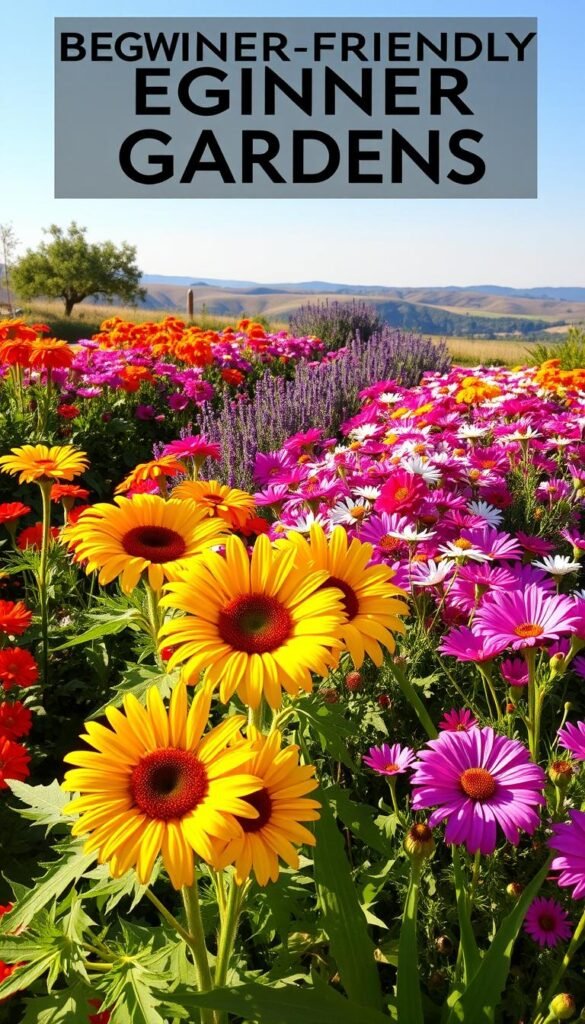Welcome to the rewarding journey of growing vibrant outdoor spaces! Many assume creating stunning displays requires years of expertise, but success lies in choosing resilient varieties that work with your lifestyle. This guide focuses on low-effort options that forgive missed waterings, imperfect soil, and other common learning curves.
You’ll discover how selecting the right species builds confidence through quick wins. Unlike delicate specimens needing constant attention, these robust picks establish themselves quickly and reward you with season-long color. Even better – they naturally resist pests and adapt to various growing conditions.
We’ve curated options perfect for those starting their first garden project. From cheerful sunflowers to drought-tolerant cosmos, each plant offers unique benefits while requiring minimal upkeep. Many bloom faster than you’d expect, with some varieties showing color in under six weeks.
This isn’t about perfection – it’s about enjoying the process. You’ll learn simple techniques for watering, soil preparation, and seasonal care that make a real difference. Whether you’re managing a busy schedule or just want stress-free beauty, these selections prove that anyone can cultivate striking displays.
Easy Flowers for Beginner Gardening: Hardy Blooms You Can’t Kill
Selecting resilient plants transforms gardening from daunting to delightful. Species that flourish with minimal care adapt to your schedule while delivering vibrant results. These natural survivors handle imperfect soil, sporadic watering, and shifting light conditions without losing their charm.
What Makes a Plant Low-Maintenance?
True garden champions thrive through built-in toughness. They recover swiftly from dry spells and resist common pests. Flexible growth habits mean they’ll prosper in clay, sandy soil, or dappled sunlight. Many multiply independently through bulbs or self-seeding, expanding your display year after year.
Why These Plants Build Gardening Confidence
Quick successes with robust blooms keep motivation high. Watching your first buds appear creates pride that fuels further experimentation. Fragrant petals and lush foliage offer instant rewards, while their reliability reduces stress. This foundation lets you master basics like watering rhythms before tackling trickier species.
By starting with these adaptable picks, you create a thriving space that grows alongside your skills. The right variety becomes a teacher, showing how small efforts yield big impact.
Understanding Your Garden’s Conditions
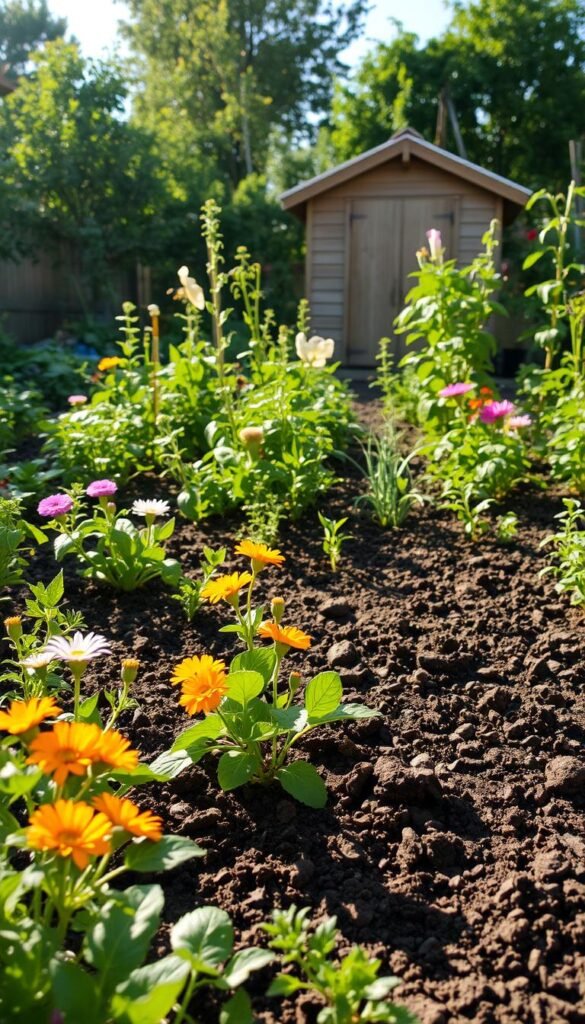
Your garden’s personality comes from its unique mix of light and earth. Observing patterns through the day reveals spots where plants will thrive with minimal fuss. This knowledge turns guesswork into strategy.
Full Sun, Partial Shade, and Optimal Soil
Full sun areas bake in direct light for 6+ hours daily – perfect for blooms craving intense energy. Track morning-to-evening patterns: south-facing zones often get the most consistent exposure.
Spaces with partial shade offer 3-6 hours of sun, usually under tree canopies or beside structures. These spots suit plants needing protection from afternoon heat. Test drainage by digging a 12-inch hole and filling it with water:
- Fast absorption (1-2 hours) indicates sandy soil
- Slow drainage (4+ hours) signals heavy clay
Well-draining earth prevents soggy roots. Mix in compost to improve texture if needed.
Choosing the Right Location for Your Blooms
Microclimates create surprising variations. A stone wall might radiate evening warmth, while low spots collect cool air. Match plants to these hidden niches for effortless growth.
“Successful gardens work with existing conditions rather than fighting them”
Clay soils retain moisture for drought-tolerant species, while quick-draining sandy patches suit Mediterranean herbs. Observe how rain pools or evaporates in different zones before planting.
Resilient Blooms to Kickstart Your Garden
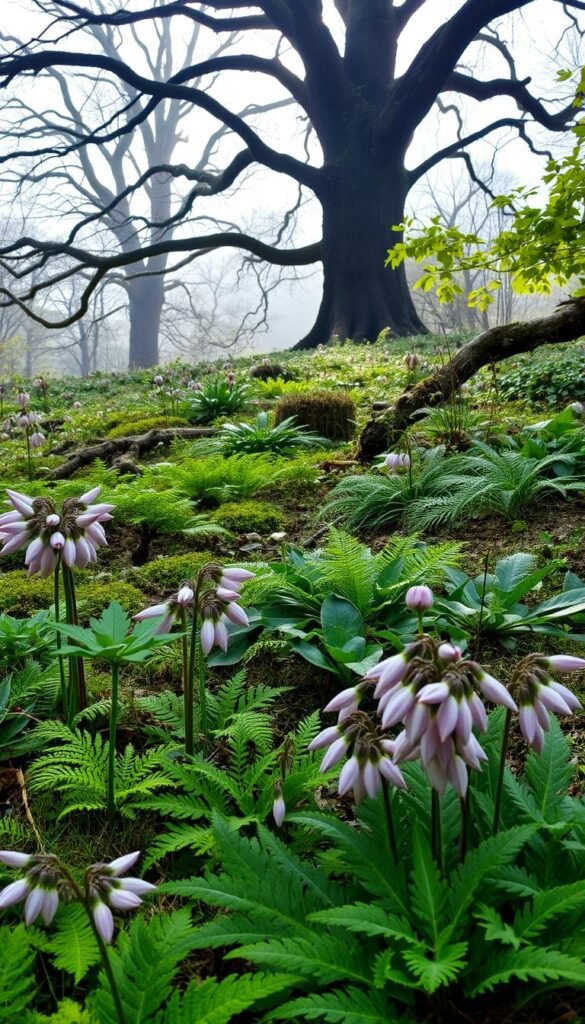
Transform your outdoor space with these unstoppable flowering plants. Their natural vigor turns hesitant first attempts into thriving displays, even when life gets busy.
Lily-of-the-Valley: Delicate Yet Tough
Don’t let the dainty bells fool you – this shade-loving warrior thrives where other plants struggle. Plant the rhizomes (called “pips”) 1-2 inches deep in moist soil under trees or north-facing walls. Space them 6 inches apart, then let nature work.
Once established, they’ll survive forgotten waterings and poor soil. Underground runners create lush carpets of fragrant white flowers each spring. Deer and rabbits avoid them, while the sweet scent becomes a seasonal highlight.
Daffodils: Cheerful Spring Stars
Nothing shouts optimism like these sunshine-yellow blooms. Choose from trumpet-shaped classics or frilly double varieties. Bury bulbs 5-8 inches deep in well-draining soil before frost hits.
They’ll burst through snow in early spring, unfazed by lingering cold. Plant en masse for impact, or mix miniature types into rock gardens. These bulbs multiply yearly, creating expanding pools of spring color that outlive most garden trends.
Low-Maintenance Perennials and Succulents
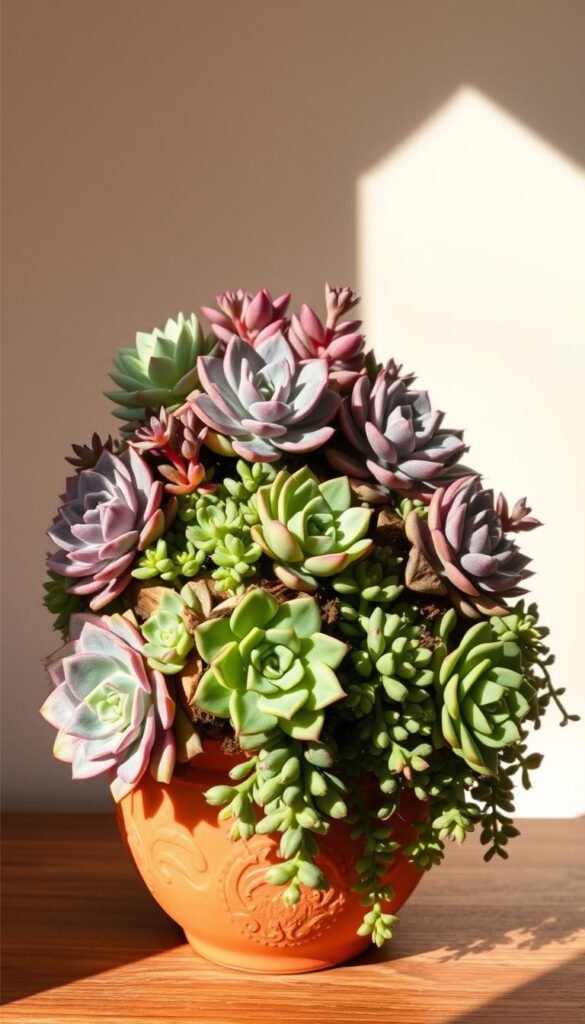
Gardens thrive when you partner with nature’s built-in survivors. Succulents and hardy perennials offer sculptural beauty without demanding constant attention, making them ideal for low-maintenance plant displays. Their water-wise habits and striking textures create visual interest year-round.
Sedum: The Indestructible Succulent
Sedum earns its “stonecrop” nickname by thriving where other plants surrender. Autumn Joy sedum bursts with coppery-pink blooms that deepen as temperatures drop. Dragon’s Blood varieties add drama with crimson foliage, while creeping types like Stonecrop form lush ground covers.
These champions need at least six hours of direct sun daily. Plant them in sandy or loamy soil that drains quickly – soggy roots are their only weakness. Space clusters 12-24 inches apart to accommodate their spreading growth.
Hens and Chicks: Simple Ground Cover
Sempervivum’s rosettes multiply like living mosaics, with each “hen” producing dozens of chicks. They handle frosty winters (zones 3-8) and summer droughts without fuss. Gravelly soil and full sun keep these succulents compact and colorful.
Water only when the ground feels bone-dry. Their shallow roots absorb moisture efficiently, making over-watering more dangerous than neglect. Let them fill gaps between stepping stones or cascade from containers for fuss-free charm.
Bright and Bold Flowers to Enhance Your Space
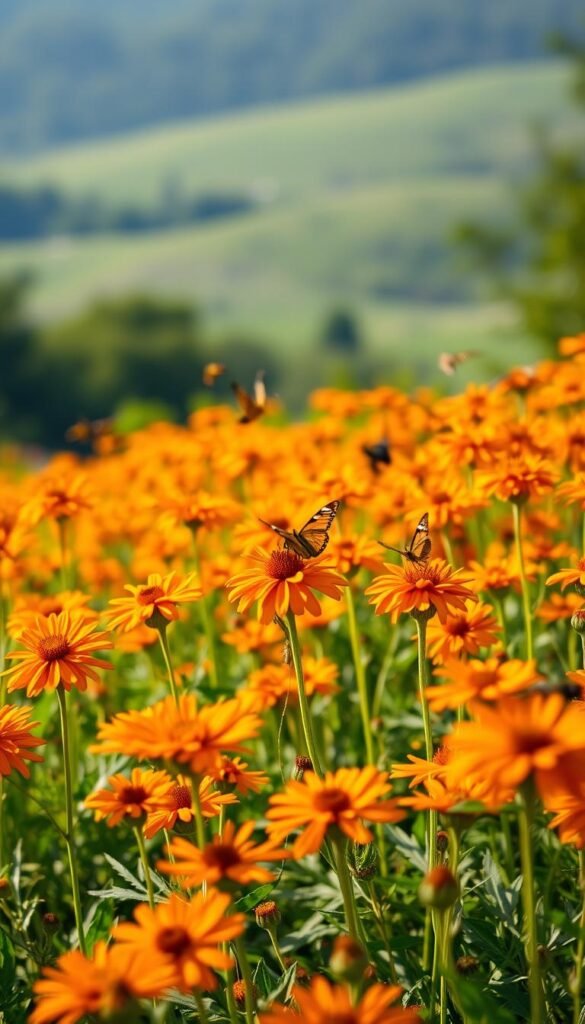
Vibrant hues do more than dazzle—they create living ecosystems. Bold colors attract essential wildlife while energizing your outdoor areas. Among these natural powerhouses, one plant stands out for its ecological impact and striking appearance.
Butterfly Milkweed: Attracting Vital Pollinators
Asclepias tuberosa bursts with fiery orange flowers that monarch butterflies can’t resist. This native perennial serves as both nursery and diner for endangered pollinators. Female monarchs exclusively lay eggs on milkweed leaves, making it critical for their survival.
Once established, this plant thrives in full sun with minimal care. Its deep roots withstand drought, while the clustered blooms feed bees and hummingbirds. Unlike fussy ornamentals, it grows well in poor soil—perfect for neglected garden spots.
| Feature | Butterfly Milkweed | Typical Garden Flowers |
|---|---|---|
| Water Needs | Low (once established) | Moderate-High |
| Pollinator Value | Essential host & food source | Limited nutritional value |
| Soil Tolerance | Grows in sandy/clay soils | Requires rich amendments |
| Sun Requirements | 6+ hours daily | Varies widely |
For best results, choose a sun-drenched location with quick drainage. Space plants 18 inches apart to allow for their bushy growth. Pair them with purple coneflowers or black-eyed Susans in a pollinator-friendly garden design.
Beyond beauty, this flowering powerhouse supports biodiversity. Its bright clusters bloom for weeks, offering lasting color. By growing milkweed, you become part of vital conservation efforts—one vibrant sun-loving plant at a time.
Tips for Watering, Fertilizing, and Garden Care
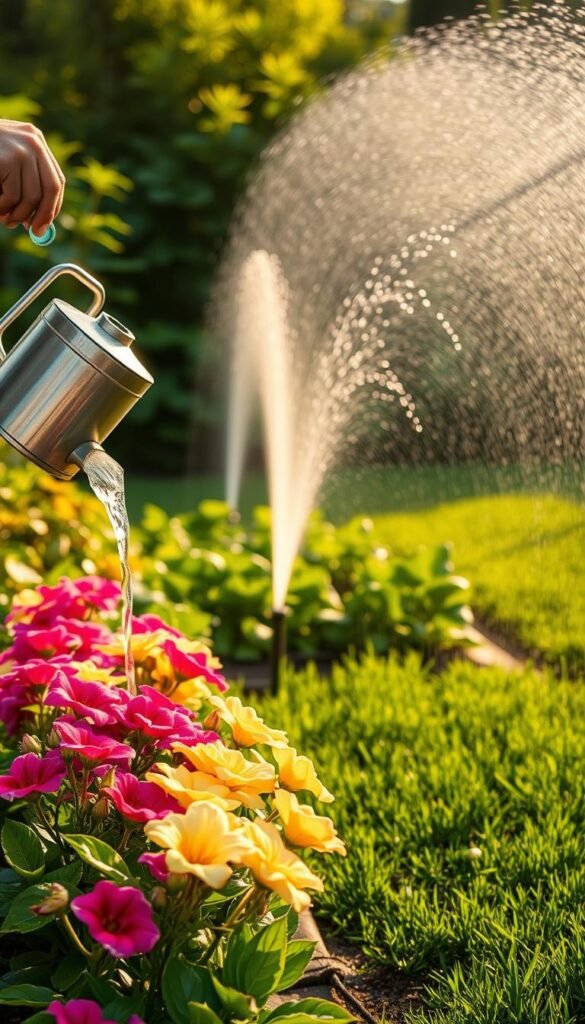
Smart hydration habits keep your garden thriving without demanding constant attention. Resilient plants need thoughtful care during their first season, then largely manage themselves. Let’s explore how to work with their natural rhythms.
Mastering Moisture Balance
Established plants develop deep root systems that tap into groundwater. Check soil moisture by inserting a finger up to the second knuckle. If it feels dry, water thoroughly at the base – morning sessions reduce evaporation.
Succulents like Sedum thrive on neglect. Wait until their soil cracks slightly before giving a deep soak. Moss Rose stores water in fleshy leaves, often needing just monthly drinks in hot climates.
| Technique | Benefit | Best For |
|---|---|---|
| Soil-level watering | Prevents leaf mold | Sedum, Milkweed |
| Deep soaking | Encourages strong roots | Newly planted perennials |
| Drip irrigation | Saves time | Busy gardeners |
“Water the soil, not the plant – roots decide a garden’s success.”
Seasonal shifts matter. Spring plantings need weekly watering, while mature gardens might require monthly checks. Pair these strategies with starting a flower garden basics for lasting results. Remember: overkindness with a hose causes more harm than drought.
Designing a Colorful and Inviting Garden Layout
Crafting a vibrant garden layout combines artistry with smart plant selection. Mix daffodil varieties like bold Trumpet types and frilly Double blooms for layered spring interest. Miniature versions add delicate accents along pathways or rock gardens.
Balance warm colors with cool-toned foliage to create visual harmony. Cluster sun-loving plants in south-facing areas, using taller species as natural backdrops. Leave breathing room between groups – overcrowding stifles growth and hides unique textures.
Your garden gains depth through contrasting shapes and heights. Pair spiky sedum clusters with rounded hosta leaves, or let trailing succulents soften stone edges. This strategic choice of companions turns simple beds into dynamic displays.
Remember: successful gardens evolve. Start small, observe how light shifts across your space, then expand plantings each season. With thoughtful design, even modest garden zones become captivating retreats that reflect your growing confidence.

